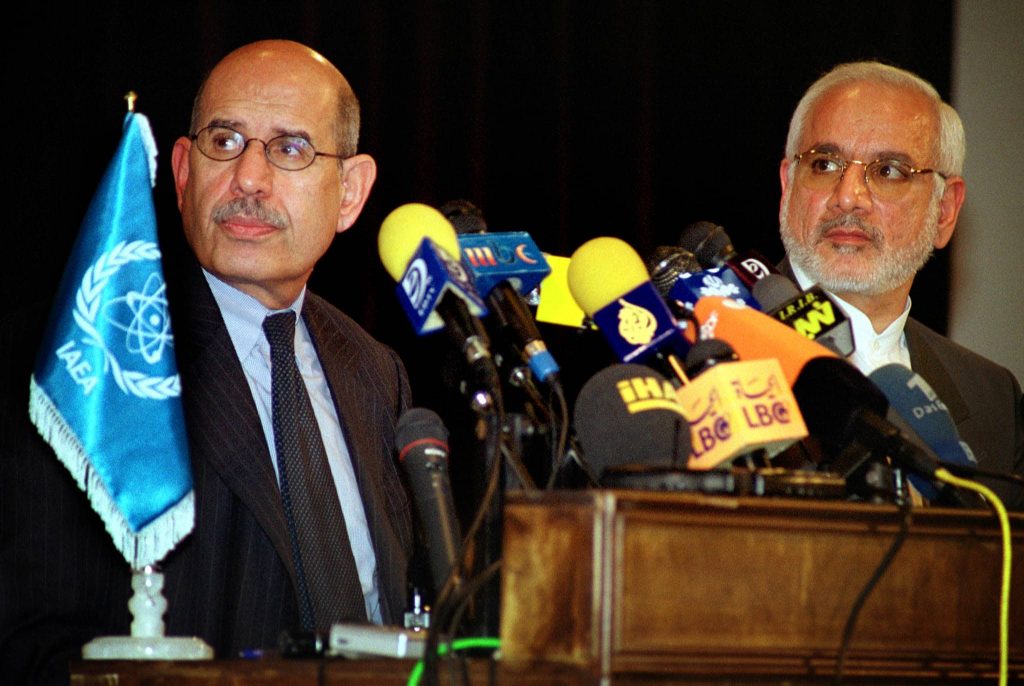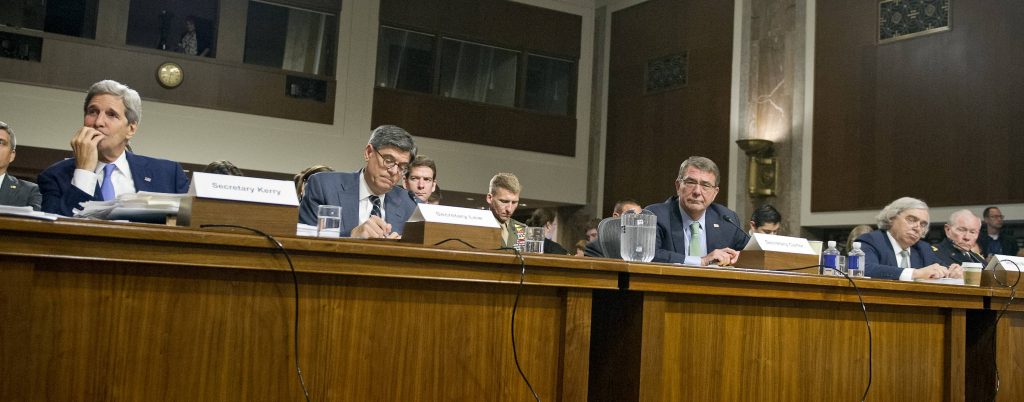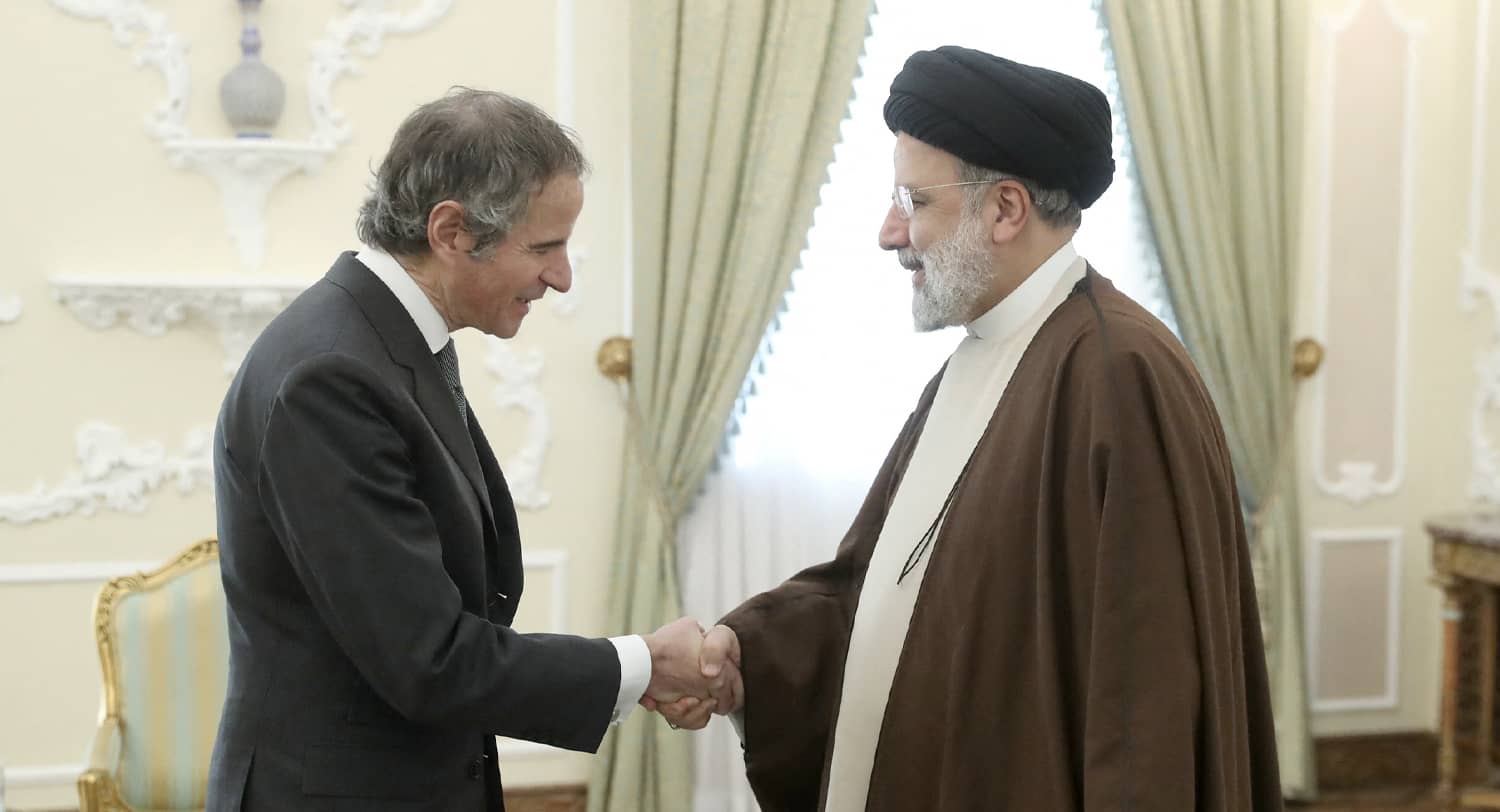Twenty years ago, on 17 March 2003, Mohammed ElBaradei, Director General of the International Atomic Energy Agency (IAEA), reported to his board that Iran was in breach of its Non-proliferation Treaty (NPT) obligations – which require a signatory to use all nuclear technology in the country exclusively for peaceful purposes and to follow a policy of transparency.
Since 2003, several agreements, road maps, work plans, and joint plans of actions have been agreed with Iran. But after 20 years of efforts, the IAEA still has not been able to conclude that Iran’s declarations are truthful and complete, and that all nuclear material and facilities in Iran have been placed under the IAEA safeguards.
Following is a summary of this history, a snapshot of the dangerous situation we currently face, and a suggested new approach that covers all aspects of an Iranian nuclear weapons program.

Former Director General of the IAEA Mohammed ElBaradei (L) speaks at a joint news conference in Tehran with Gholam Reza Aghazadeh, former head of Iran’s Atomic Energy Organization, February 2003. Photo credit: REUTERS
Joint Comprehensive Plan of Action (JCPOA)
The United Nations Security Council (UNSC) imposed sanctions in 2006 following a resolution by the IAEA Board of Governors that Iran was in noncompliance with its NPT safeguards agreement obligations. These sanctions did not stop Iran from proceeding gradually with its uranium enrichment activities. Diplomatic efforts finally culminated in 2015 with the JCPOA agreed between Iran and China, France, Germany, the Russian Federation, the United Kingdom and the United States, a text later endorsed by the UNSC.
The JCPOA set restrictions on Iran’s nonproliferation related activities, while UNSC Resolution 2231 added a ban on the development of ballistic missiles designed to be capable of carrying nuclear warheads. The JCPOA provisions also set a limit on stocks and types of nuclear material in Iran, and mandated the conversion of the Fordow enrichment plant to a facility producing stable isotopes instead of enriching uranium, and imposed restrictions on uranium enrichment research and development. The heavy water reactor, which is under construction in Arak, was to be modified to produce less plutonium, and Iran would for the time being forgo any reprocessing activities to separate plutonium.
The agreement included some weak monitoring of nuclear weaponization activities. Monitoring of nuclear activities were assigned to the IAEA. Nuclear and nonnuclear restrictions were, however, designed to expire over time regardless of progress or non-progress made by the IAEA verifying the correctness and completeness of Iran’s declarations.
The proponents of the agreement felt or hoped that it would change Iran’s behavior in the region, assist Iran to develop its civilian nuclear program and meet its NPT safeguards obligations. The Trump administration sought first to modify the JCPOA, and then finally decided to leave the agreement. After the withdrawal of the US from the JCPOA, Iran started to reduce, step-by-step, the implementation of its nuclear-related JCPOA commitments on and, from 23 February 2021 onwards, fully suspended the implementation of those commitments.

Iran’s Nuclear Weapons Development
Iran’s progress with all major components of a nuclear weapon – production and stocks of high-enriched uranium, development of missiles capable of delivering nuclear warheads, and its past work on weaponization – have raised international concerns. CIA Director Bill Burns told CBS News in February that Iran’s nuclear enrichment program has advanced to the point in which Tehran could in a “matter of weeks” have enough enriched uranium for a nuclear weapon.
Burns went on to say that “to the best of our knowledge, we don’t believe that the Supreme Leader in Iran has yet made a decision to resume the weaponization program that we judge that they suspended or stopped at the end of 2003.” Burns reiterated that the US has no knowledge that Iran has resumed its nuclear weapons program.
He was referring to the “Amad” project (the code name given by Iran to the nuclear program as conducted between 1989 and 2003: it is a first name meaning “praiseworthy”) which was planned to manufacture in four years’ time four nuclear weapons and one explosive nuclear device for testing. Details of this plan came much clearer when Israel captured documentation of the program archived in a warehouse in Teheran 2018.
Subsequently the IAEA was able to visit some of the relevant sites, identified in the Israeli-discovered archive, which raised additional concerns on the uranium particle contamination found there. Iran’s explanations on the particles found do not match with the IAEA findings of March 2022. The IAEA sought explanations from Iran as to the presence of uranium particles of anthropogenic (man-made) origin identified by the Agency at three undeclared locations in Iran – Turquzabad (2019), Varamin (2020) and ‘Marivan’ (2020).
One of the questions raised by the archive and by IAEA visits is whether the weapons program was ever terminated, and whether relevant work has continued covertly as some of the AMAD program documents indicate..
Now that uranium enrichment capability has reached a new level, as Burns says, “at a worrisome pace,” it is increasingly important to address these issues, dismantle the weapons program in a verifiable manner, and agree on further confidence building measures to ensure that Iran’s nuclear program indeed serves only for peaceful purposes.
Iran’s Enrichment of Uranium Up to 84 %
Iran has fully suspended the implementation of its nonproliferation commitments: and in practice, gradually increased its enrichment capability by developing and installing more advanced centrifuges at Natanz and Fordow enrichment plants. It has also increased uranium enrichment levels by passing the 3.67 % maximum level allowed by the JCPOA – proceeding first to 20 % and then to 60 % enrichment level.
In order to achieve this, Iran has also experimented with various designs of enrichment cascades. In February 2023, the IAEA reported that Iran had made changes to the cascades without announcing in advance the implementation of those modifications to the Agency, as required under the safeguards agreement.
Another recent matter of concern is that the IAEA found in samples taken at Fordow enrichment plant uranium particles enriched to 84 % level, which qualifies as weapons-grade material.
IAEA Director General Rafael Grossi had meetings on 3 and 4 March 2023 in Teheran to address issues related to the presence of uranium particles in the three new locations mentioned above, changes in the cascade design without proper notification, presence of uranium particles enriched to 84 % level, and new restrictions imposed by Iran after the US withdrawal from the JCPOA.
In his report to the IAEA Board Grossi made a reference to the Joint Statement concluded with Iran that “ …Iran’s agreement to allow the Agency to proceed with further monitoring and verification measures indispensable to the Agency fulfilling its mission”. The IAEA still needs to agree on modalities for the prompt and full implementation of such measures. Iran has made promises, but whether or not these will be followed by actions remain to be seen.
Stockpiling of High-enriched Uranium
During the last two years the enrichment program has shifted from production of low-enriched uranium, at levels below 5 % U-235 – used for light water reactors – to enrichment up to 60 % U-235, for which material there is no plausible use in Iran’s civilian nuclear program.
Over the past 18 months, reactor grade uranium stocks got smaller, but higher enriched quantities are four times bigger than they were in November 2021.
The breakout time until Iran possesses enough material for a weapon has become dangerously short. When one has reached 20 % level, one has done 90 % of the effort needed to achieve weapons grade (enrichment level around 90 % U-235). With 60 % enriched uranium, 95 % of the effort has been done.
The Mossad has estimated that Iran could produce enough weapon-grade uranium for five nuclear weapons in one month and seven in three months by modifying existing enrichment cascades.This estimate is in line with the statement made in February by Colin Kahl, the US Under Secretary of Defense for Policy, that Iran could have enough weapons grade enriched uranium for the first weapon in 12 days, which leaves very little time for the international community to respond to such a development.

The breakout calculations made above are based on the IAEA standard of significant quantities, which require 25 kg U-235 uranium at 90 % enrichment level for a bomb. However, this standard applies to a “newcomer” state making its first nuclear weapons. With experience of the needed explosive power, quantities required could be substantially less, e.g., 14 kilograms of weapons grade material. This is why a full understanding of the design of the AMAD weapon, which received substantial assistance from a foreign weapons expert – the Pakistani A. Q. Khan – and subsequent possible developments are vital to ensure that the program has indeed been dismantled.
Unfortunately, the IAEA Board was not able to agree to censure Iran’s actions in its meeting on 6 March 2023, nor to refer the case to the UN Security Council for action. The production of additional higher enriched uranium continues, which together with Iran’s other actions does not contribute to the peace and security in the region.
An Improved Agreement
President Biden privately remarked in November 2022 that the 2015 Iran JCPOA was “dead.” Clearly, new verification arrangements are needed. A return to the old agreement and practices will not guarantee success.
We must craft a verifiable long-term credible agreement covering all three elements of a nuclear weapons program: production of fissile material, weaponization, and means of delivery using ballistic and cruise missiles. This will require building an independent, open, credible monitoring and verification system, reflecting the strengths of the IAEA verification system: access to information, sites, equipment, materials and people. Such a regime should be based on the IAEA safeguards system, yet expanded by special units for weaponization and missile delivery systems.
It will be an uphill battle. There are differences in views between the US, China and Russia. There are also suggestions that China may host a joint event between the GCC and Iran, which could further complicate the international approach to Iran.
Here are the basic elements of a viable verification system.
- Sanctions relief, acquisition of sensitive technologies, and Iran’s compliance with the reporting and verification obligations should be reviewed annually, based on performance. (For example, enrichment capabilities would not be increased automatically, but in the light of Iran’s compliance with its safeguards obligations and new undertakings, dismantlement of the nuclear weapons related capabilities, and actual enrichment needs of the nuclear civilian program.)
- Iran should ratify and implement the Additional Protocol – namely, the set of enhanced monitoring measures to ensure that nuclear projects are non-military in nature, adopted by teh IAEA in 1997.
- A two-year goal should be set for verifying the accuracy and completeness of Iran’s NPT safeguards undertakings.
- The IAEA should be provided with full access to all relevant information and sites, including the scientists involved in past and current activities.
- The verification regime should cover production of fissile material, weaponization, and ballistic and cruise missiles. Due to the recent developments regarding cruise missiles , which have not at all been covered by the JCPOA, these need to be included.
- Any nuclear weapon related activities should be verifiably terminated, single use equipment rendered harmless or disposed, and relevant facilities irreversibly dismantled.
- The IAEA should have full access to relevant information including the scientists involved in past and current activities.
- The reporting of the progress on the new measures by the IAEA and UNSC should be public in order to reduce tensions in the region, but without releasing sensitive information.

